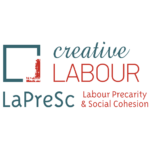Bellini, A., Burroni, L., Dorigatti, L., Gherardini, A., & Manzo, C. (2018). Industrial relations and creative workers. Overall report. IR-CREA – Strategic but vulnerable. Industrial relations and creative workers Project funded by the DG Employment, Social Affairs & Inclusion of the EC.
Cultural and creative industries are a strategic factor in developing the European economy. Furthermore, they are a promising terrain for the modernization of labour markets. In particular, the vibrancy of these sectors allows job creation for educated workers. They are nevertheless heterogeneous. Workers are polarized between those employed in large firms, who benefit from high wages and good working conditions, and those contracting out their skills to small (and flexible) organizations, who suffer from low income and high uncertainty. These latter are seen as vulnerable. Vulnerability is a major focus of the literature on creative work. Scholars emphasize the extensive use of non-standard and freelance work, normally associated with little job security, limited access to welfare and low income levels. A common assumption is that, to cope with material deprivation, they adopt a self-reflexive approach and generate intrinsic rewards. Despite their vulnerability, most creatives are reluctant to join trade unions; on the other hand, the unions have difficulties in finding effective forms of organization. Given these premises, the paper seeks to answer a series of questions about: the role of institutions in reducing market risks in sectors characterized by high vulnerability and low unionization; the capacity of the actors of industrial relations to develop innovative representation strategies; the role of other actors, such as professional associations, in a field usually presided by trade unions; the emergence of new actors, which respond an outstanding demand for representation. For this purpose, it presents the findings of a project funded by the European Commission, namely IR-CREA. In detail, the first section provides a combined review of three literatures, focusing on creative work, professions and industrial relations. The second section gives an overview of the results of two sectoral studies, graphic design and video game development, conducted in three countries, Denmark, Italy and the Netherlands, trying to identify common patterns and specificities. Based on the analysis of semi-structured interviews with key informants, it provides insights into sectoral dynamics concerning working conditions, and their implications for interest representation. The attention goes to innovative practices, in the prospect of a “revitalization” of union action. The third section offers some interpretive explanations and discusses their theoretical implications.
flore.unifi.it/retrieve/e398c37d-bb1f-179a-e053-3705fe0a4cff/WPA2_Overall report.pdf

